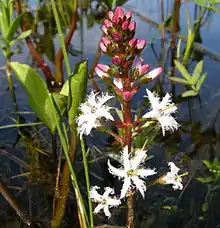Menyanthes
Menyanthes is a monotypic genus of flowering plants in the family Menyanthaceae containing the single species Menyanthes trifoliata. The North American form is often referred to as M. trifoliata var. minor Michx. It is known in English by the common names bogbean[1] and buckbean.
| Menyanthes | |
|---|---|
 | |
| Scientific classification | |
| Kingdom: | Plantae |
| Clade: | Tracheophytes |
| Clade: | Angiosperms |
| Clade: | Eudicots |
| Clade: | Asterids |
| Order: | Asterales |
| Family: | Menyanthaceae |
| Genus: | Menyanthes L. |
| Species: | M. trifoliata |
| Binomial name | |
| Menyanthes trifoliata | |

Description
Menyanthes trifoliata has a horizontal rhizome with alternate, trifoliate leaves. The inflorescence is an erect raceme of white flowers. The buds are rose-pink in color. The flowers when fully open look like "white stars" and the petals are fringed with white whiskers.[2]
The species occurs in fens and bogs in Asia, Europe, and North America. In eastern North America, it is considered to be a diagnostic fen species.[3] It sometimes creates big quagmires with its thick roots.
Taxonomy
The name Menyanthes comes from the Greek words menyein, meaning "disclosing", and anthos, meaning "flower", in reference to the sequential opening of flowers on the inflorescence.
Fossil record
One fossil seed of Menyanthes trifoliata has been extracted from borehole samples of the Middle Miocene fresh water deposits in Nowy Sacz Basin, West Carpathians, Poland.[4]
Conservation
The species is protected in the United States.[5]
Uses
The rootstock can be ground into an unpalatable flour for emergency use.[5] The plant has a characteristic strong and bitter taste, which can be used in schnapps.
In China, the plant is known as "Sleeping herbs 睡菜" or "Herbs that calm consciousness 暝菜": Guangdong Xing Yu (1678), a Qing dynasty book by Chiu-Da-Jun, records: "Eat [Menyanthes trifoliata;] makes people sleep well." The Compendium of Materia Medica records: "[Treats] insomnia, restlessness".
References
- BSBI List 2007 (xls). Botanical Society of Britain and Ireland. Archived from the original (xls) on 2015-06-26. Retrieved 2014-10-17.
- Stevens, John (1987). The National Trust book of Wild Flower Gardening. London: Dorling Kindersley. p. 104. ISBN 978-0-86318-219-8.
- Godwin, Kevin S.; Shallenberger, James P.; Leopold, Donald J.; Bedford, Barbara L. (2002). "Linking landscape properties to local hydrogeologic gradients and plant species occurrence in minerotrophic fens of New York State, USA: A Hydrogeologic Setting (HGS) framework". Wetlands. 22 (4): 722–37. doi:10.1672/0277-5212(2002)022[0722:LLPTLH]2.0.CO;2. S2CID 20623975.
- Łańcucka-Środoniowa M.: Macroscopic plant remains from the freshwater Miocene of the Nowy Sącz Basin (West Carpathians, Poland) [Szczątki makroskopowe roślin z miocenu słodkowodnego Kotliny Sądeckiej (Karpaty Zachodnie, Polska)]. Acta Palaeobotanica 1979 20 (1): 3-117.
- Peterson, Lee Allen (1978). A Field Guide to Edible Wild Plants of Eastern and Central North America. Boston: Houghton Mifflin. p. 22. ISBN 0-395-20445-3. OCLC 3541725.
External links
 Media related to Menyanthes trifoliata at Wikimedia Commons
Media related to Menyanthes trifoliata at Wikimedia Commons Data related to Menyanthes trifoliata at Wikispecies
Data related to Menyanthes trifoliata at Wikispecies- Jepson Manual Treatment
- USDA Plants Profile
- Photo gallery